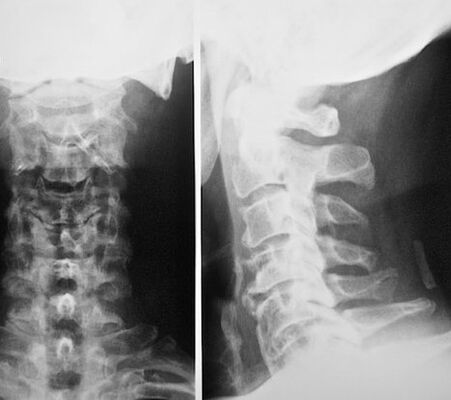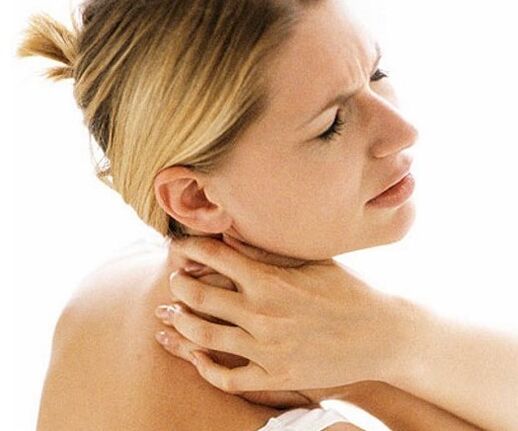Of all the diseases known to mankind, the most common is the disease in supportive motor equipment. It is unlikely that there is a person under 40 who do not experience problems with the spine, does not complain about joint pain or muscles. The reason for this phenomenon is most often a sedentary lifestyle when they are deposited in the joints with a decrease in motor activity, decrease salts and other harmful substances, which disrupt the functionality of the bone system. It is generally accepted that the diseases of the supporter and the motor orata occur only in people of mature age, but in recent years young people are often diagnosed with this type of disease. It is quite difficult to treat such diseases, especially when it is degeneratively - the distrustal changes, bones and nerve tissues that affect the adjacent cartilage occur in the tissues. Of the many diseases that violate the structure of the bone system, they have a special place for a disease such as cervical osteochondrosis, which is considered to be the most common disease of our time, and is found not only in people of mature age but also in young people under 35 years of age.
The cervical region osteochondrosis is a progressive disease, such as early treatment and later seeing spina, can lead to human disability. What are these misleading disease? What are the symptoms of the cervix osteochondrosis and how to treat this disease?
How does the cervix develop osteochondrosis?
Cervical osteochondrosis is a progressive disease characterized by degenerative -dyclic changes in intervertebral discs that provide deformation, altering their structure, which cause many prominent symptoms. The risk of developing osteochondrosis of the cervix region is people who live a sedentary lifestyle or whose professional activities are in the same position for a long time. In terms of osteochondrosis, damage to the cervical spine is in second place after lumbosacral osteochondrosis. The peculiarity and complexity of the disease is that the lesion of the cervical region almost always affects the nerve roots of the spine nerves and intervertebral discs, which result in large and small blood vessels overcoming the blood supply to the brain.
The cervical compartment has a complex structure and consists of 7 vertebrae, each of which performs many functions: it supports the head, turns, bow, bow and bow and other important functions. There are intervertebral discs between the vertebrae, which make the spine flexible and durable, and the intervertebral discs consist of fibrous rings that are interior. The cervical vertebrae fit together, so even less physical activity can cause the displacement, which in turn causes the blood vessels and nerves. In the cervical spine, the spine arteries are responsible for the blood supply to the brain. When connected, blood supply is disturbed, the brain does not receive sufficient amounts of vital substance, which undoubtedly leads to the defeat and development of many complications, which can lead to the patient's disability or even death.
The main causes of cervical osteochondrosis
Despite the fact that the pathogenesis of osteocondrosis of the cervical spine has not been fully studied in this disease and in modern medicine. It is known that the disease in the cervical spine may develop in the background of metabolic damage, which over time leads to a change in the structure of intervertebral discs and spinal bodies. Among other types of osteochondrosis, the cervix is the most dangerous because its development is compressed by the spinal cord and blood vessels, which will undoubtedly lead to a violation of blood supply to the brain cells. In the pathogenesis of the disease, doctors distinguish a number of provocative factors that can lead to the onset of the disease.
- Sitting lifestyle.
- Violation of metabolic processes in the body.
- Salt deposits in the cervix region.
- Inappropriate or unbalanced diet;
- Long -term interruption of the body in one position: working on a computer, driving a car.
Cervical osteochondrosis can lead to factors that are distinguished by experts who threaten the risk of developing the disease.
- Genetic predisposition.
- Injuries of the cervical spine.
- The body is long -term or periodic hypothermia.
- Hormonal imbalance.
- Chronic disease of the support and motor device: rheumatism, skoliosis, systemic lupus erythematosus.
- Overweight.
The cause of the cervical osteochondrosis may be other reasons, but in any case the disease should be treated with the first signs.
How to recognize the cervical region osteochondrosis and what are the signs?
Clinical symptoms of cervical osteochondrosis develop slowly to osteochondrosis of the cervix. Symptoms of the disease depend on the degree and number of injured vertebrae and the tightening of nerve endings. The main symptom of the disease is pain of different intensity at the lower back of the spine, neck and back, which is given by other organs. Only one doctor can diagnose "cervix osteochondrosis" after examination results, as the variety of disease clinics is often similar to other abnormalities, but everyone can suspect this disease.
- Cervical pain that gives the back of the head, ears, front, forearm, chest, shoulder. Painful feelings of different intensity are improved by minimal load or head turning.
- Numbness of the upper and lower limbs, burning, tingling.
- Headache, dizziness.
- Demolition.
- He darkens in his eyes, "flying" in the eyes.
- Fainting with a sharp turn of the head.
- Noise in the ear.
- Numbness of the tongue.
- Violation of coordination.
- Reducing hearing, visual acuity.
- Pain in the heart.
Clinical symptoms of osteochondrosis of the cervix that express and appear when the disease develops and progresses. Doctors involved in the treatment of the disease distinguish a number of syndromes of osteochondrosis of the cervix, each of which has its own characteristics and manifests itself depending on the damaged nerve spine.
- Rest syndrome - As a result of pinching the first pair of nerve endings, it develops in the cervical spine. The patient feels severe pain in the neck, which is added to the plate, the lower back, the shoulder and the forearm.
- The spinal arterial syndrome is characterized by a pulsating headache in the back of the head or temporal region. Irritation reflector syndrome burning pain in the neck and chest, which increases the head, sleep or cough, to the chest and shoulder.
- Cardial syndrome is a whole group of symptoms that initially resemble angina pectoris symptoms. This syndrome develops when damaged the diaphragmatic nerve spine or large chest muscle. The main signs are considered as the painkiller pain in the heart that does not pass after taking nitroglycerin. Such pains can last for several hours and can increase during driving or deep breathing. In the patient, such symptoms cause panic because they resemble a heart attack.

Cervical osteochondrosis symptoms
Cervical osteochondrosis - symptoms and treatment directly depends on the injured nerve spine. The number of cervical roots is 8 and the cervical chips are 7. All cervical nerves are above the vertebrae and the damage has its own symptom.
If the first and second cervical vertebrae (CI-II) was defeated, the sensitivity of the back of the head was disturbed, which attracts pain in the parietal and occlital region.
The lesion of the nerve ending (C3) is extremely rare, but despite this, when injured, the patient feels numbness in the area where the stings occurred. The speed and sensitivity of the tongue are also impaired.
The lesion of the c4 nervous spine causes pain and numbness in the collar or shoulder. Disorders of the respiratory system, the heart of the heart is observed.
If the vertebrate segment of Class 5 is disturbed, the patient will feel the pain on the shoulder, the exterior of the shoulder, the sensitivity of the upper and lower limbs.
The pinching of the roots of C6 and C7 is the most common phenomenon among patients. Patients feel pain in the neck, blade, forearm, back, lower back, hands sensitivity, fingers.
When the nerve spine is influenced, the pain is spread throughout the neck, back, elbows, and adds to the lower limbs. We observe the numbness of the small fingers of the arms and legs, and the sensitivity of the skin is virtually absent. The legs and hands of the hands get a bluish shade due to the damaged blood circulation.
In addition to pain syndromes, the cervix complains of other diseases described above in the signs of the disease: damaged vision, dizziness, fainting, etc.
Media Physical Education for the Cervical Osteochondrosis
Only after a doctor's consultation should be done and physiotherapy exercises. In addition, exercise should discuss all execution with a specialist, as the poor position of the neck or limbs can even harm your health and exacerbate treatment. Note some safe exercises that can be done and should be performed in patients with osteochondrosis in the cervix.
- Home in a flat surface - divide your arms to the side. Raise your arm, turn your body with light movements a little left, to the right. The left palm of the hand touches his right palm and vice versa. Do such exercises 5-6 times.

- Stretch your arms along the body when the stomach is lying. Try relaxing your muscles and slowly turn your head left and then to the right. You should try to touch the edge of the ear. They can do such an exercise as in the photo. Complete 8-10 times.
- Lying on your stomach, try to bow your chin to your palms, your cervical muscles must be relaxed. Do it five times.
- Drink your head a little and then lower it. Cervical muscles are resistant, so such a exercise should be carefully done. Repeat the exercise 5-6 times.
- You have to get up exactly, straighten your shoulder. Then slowly turn the head to the right and then to the left. So 5-6 times.
- Enhance your fingers on the back of the head, put your elbow together, put your forearm state. Try to raise the reduced forearm as much as possible. Repeat such an exercise 5-6 times.
- Take your knees. With slow motions, lift your head and freeze your body, stretching your arm. So 5-6 times.
Physical education is quite effective in treating the cervix osteochondrosis, but all exercises should be done regularly and correctly. Of course, the condition does not improve compared to the first classes, so it must be patient.
Treatment of osteochondrosis of the cervix class with folk drugs
Traditional medicine has also shown its effectiveness in the treatment of cervical osteochondrosis, which for decades has collected many recipes in its arsenal for hundreds of years, which promotes the symptoms of the disease. Treatment of osteochondrosis with folk drugs to use vegetable and animal products for external or internal use.
Recipe 1 recipe. Honey from the cervix osteochondrosis. You will need 1-2 teaspoons of natural bee honey, 2 tablets. Honey and mummy should be heated, warm scarf and fasten the neck at night. Honey has a pronounced anti -inflammatory, biostimulating properties, so it can perfectly complement the treatment of this disease.
2nd recipe. Celery from osteochondrosis. Pour 4 - 5 grams of celery with 1 liter of boiling water, stick for 2-4 hours, stretch and take 1 large spoon three times a day.

3 recipe. The decoction of chamomile and olive oil. You will need 30 grams of chamomile flowers, 0, 5 liters of olives inappropriate oil. The chamomile flowers should be poured into the oil, small fires, boil and cool. For 2 days, stick to the decoction, then filter for full transfer and rub the sick areas with the resulting oil. Together with chamomile, other herbs can be used: Celandine, Calendula, St. John's Wort. If there is no olive oil at hand, you can take it with sunflower.
Other tools for conventional medicine also help relieve cervical osteochondrosis symptoms. However, it is important to note that such treatment is only effective at the beginning of the disease and can only be used in complex treatment by conventional methods.
Prevention
Prevention of osteochondrosis of the neck is an active lifestyle. In cases where the disease is developed, a doctor - orthopedics should be visited regularly. No less important is the food that should be useful in rich vitamins, minerals and other charity. Prevention or correction of overweight, as well as regular physical exercises reduce the risk of developing cervical osteochondrosis.
- Take your knees. With slow motions, lift your head and freeze your body, stretching your arm. So 5-6 times.
- Home in a flat surface - divide your arms to the side. Raise your arm, turn your body with light movements a little left, to the right. The left palm of the hand touches his right palm and vice versa. Do such exercises 5-6 times.


















































